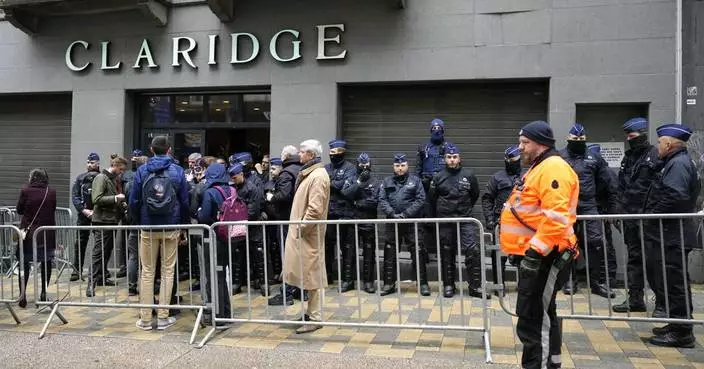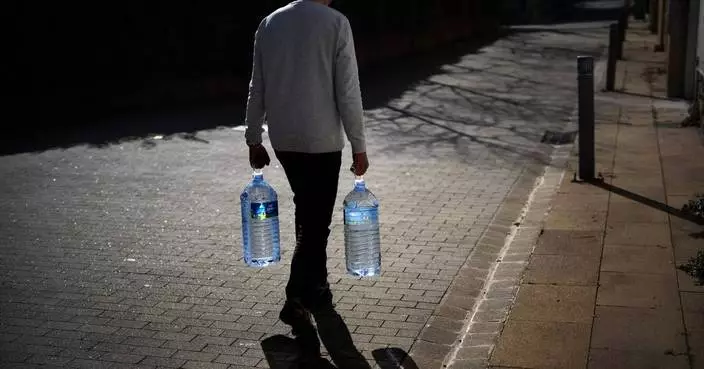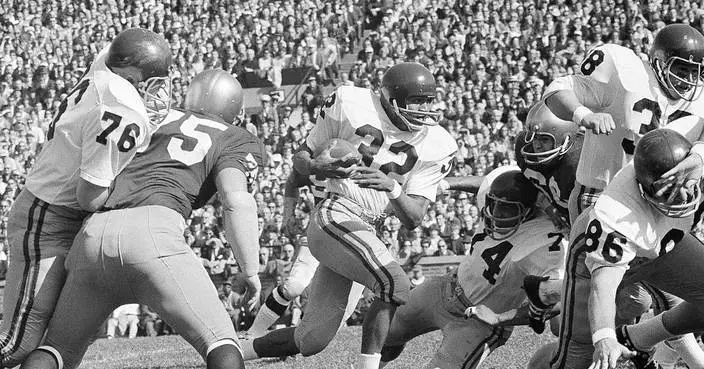This story was first published after Allied troops entered Paris on Aug. 25, 1944 to liberate the French capital from Nazi occupation. The Associated Press is republishing a version of the story to mark the 75th anniversary of the important moment in World War II, along with wartime photos . It was the first witness account published in the U.S. press, and was passed through field censors.
Street fighting raged through the heart of Paris today as American and French columns drove into the city from the south amid a tumultuous welcome from hundreds of thousands of Parisians.
Click to Gallery
This story was first published after Allied troops entered Paris on Aug. 25, 1944 to liberate the French capital from Nazi occupation. The Associated Press is republishing a version of the story to mark the 75th anniversary of the important moment in World War II, along with wartime photos . It was the first witness account published in the U.S. press, and was passed through field censors.
An American infantry column drove to Notre Dame at 11 a.m. in a spectacular ground attack to close in on strongholds still defended by the embattled Germans and the Vichy French militia.
Joyous, happy throngs who greeted the entrance of the tanks and infantry with a thundering welcome fled to the safety of buildings, and within a few minutes the streets that had been choked with humanity, laughing and crying over the liberation, were bare battlegrounds.
But Frenchmen are fighting Frenchmen as well as Germans in liberating a city wild with happiness over the freedom which they waited for four years.
All the emotions suppressed by four years of German domination surged through the people. The streets of the city as we entered were like a combined Mardi Gras, Fourth of July celebration, American Legion convention and New Year's Eve in Times Square all packed into one.
The first French column to enter the city reached Luxembourg at 10:20 a.m. The Germans, the collaborationist militia and the French Gestapo organization opened fire with machine guns, rifles and pistols and the battle was on.
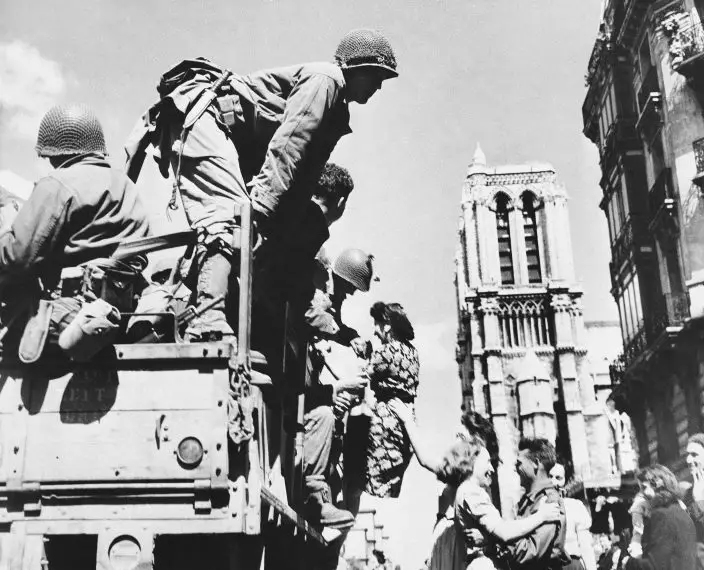
FILE - In this Aug. 28, 1944 file photo, French girls rush to greet American soldiers upon their arrival in Paris. The fighting for the liberation of Paris took place from August 19 to August 25, 1944. The French Resistance staged an uprising against the Nazis, leading attacks against German soldiers and vehicles and building barricades in the streets of the French capital. Towers of Notre Dame are in background at right. (AP Photo, File)
An American infantry column drove to Notre Dame at 11 a.m. in a spectacular ground attack to close in on strongholds still defended by the embattled Germans and the Vichy French militia.
The columns fought toward the center of the city where 5,000 French Forces of the Interior (the French Resistance) and city police have held out for the past week.
Machine guns and rifles cracked on all sides as the column I was with drove to within a block of the Luxembourg.
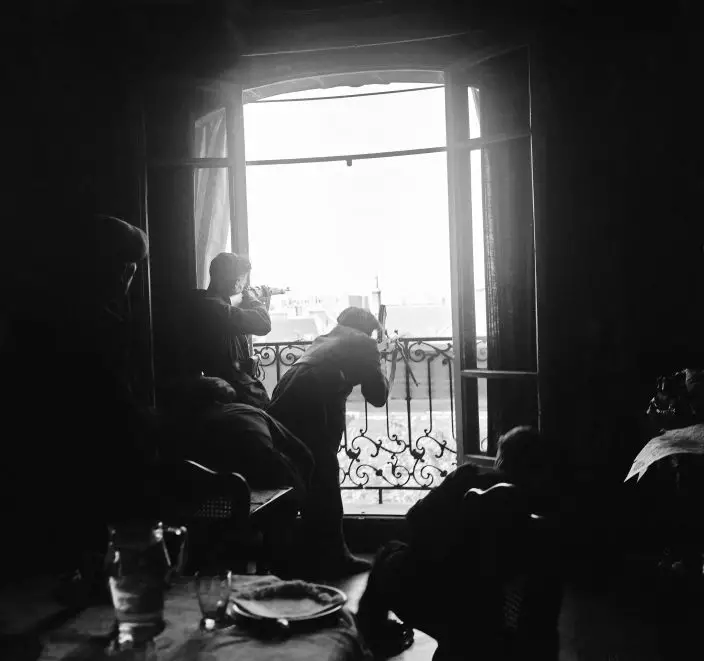
FILE - This Aug. 26, 1944 file photo shows members of the French Forces of the Interior (FFI) shoot at German snipers from a window in Paris. The fighting for the liberation of Paris took place from August 19 to August 25, 1944. (AP PhotoPeter J. Carroll, File)
Joyous, happy throngs who greeted the entrance of the tanks and infantry with a thundering welcome fled to the safety of buildings, and within a few minutes the streets that had been choked with humanity, laughing and crying over the liberation, were bare battlegrounds.
As I write this story, the Germans are still holding out in the area on both sides of the Seine halfway along the Champs-Elysees, Place de la Concorde, Qua d'Orsay, Tuileries, gardens of the Louvre, the Madeleine, the Chamber of Deputies, the Senate and the Hotel Crillon.
French patriots have a grip on the Ile de la Cite, the Palais de Justice, the Prefecture of Police, the Prefecture of the Seine, most of the Mairies (neighborhood town halls) and the factory district.
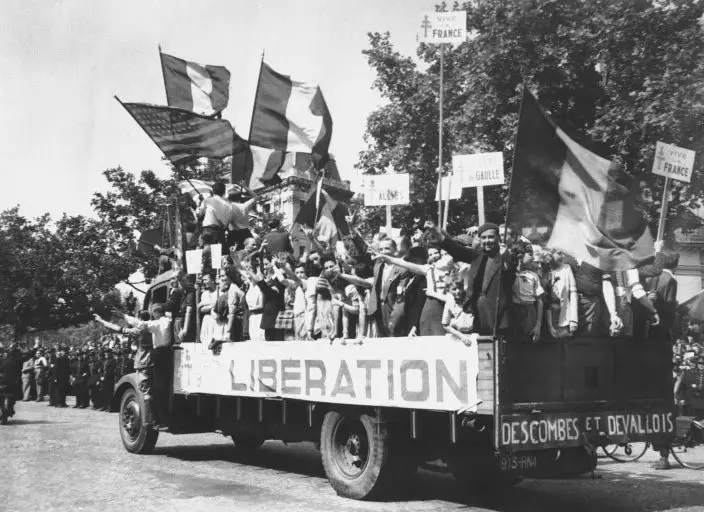
FILE - In this Aug. 28, 1944 file photo, a truck load of Parisians waving flags and carrying Vive De Gaulle banners drives through the streets of a madly rejoicing Paris. The fighting for the liberation of Paris took place from August 19 to August 25, 1944. The French Resistance staged an uprising against the Nazis, leading attacks against German soldiers and vehicles and building barricades in the streets of the French capital. (AP Photo, File)
But Frenchmen are fighting Frenchmen as well as Germans in liberating a city wild with happiness over the freedom which they waited for four years.
There was so much confusion and excitement over the entrance into the city that it is difficult to give a coherent account of the events that moved so swiftly, once the French armored column began rolling through the heavy morning fog that made vehicles look like prehistoric monsters appearing out of the swamps of creation.
But when the last enemy resistance crumbled at the gate to Paris, then this heart of France went mad — wildly, violently mad with happiness.
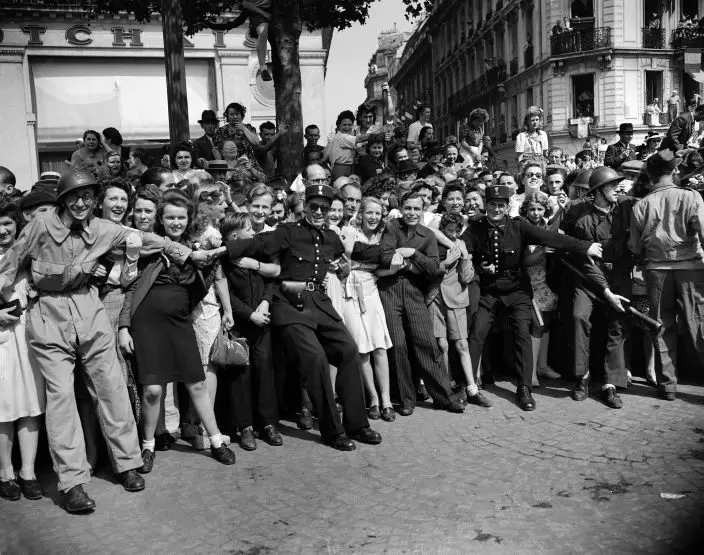
FILE - In this Aug. 26, 1944 file photo, gendarmes and F.F.I. hold back crowds of people as they throng the streets to see General Charles De Gaulle in Paris. The fighting for the liberation of Paris took place from August 19 to August 25, 1944. (AP PhotoLaurence Harris, File)
All the emotions suppressed by four years of German domination surged through the people. The streets of the city as we entered were like a combined Mardi Gras, Fourth of July celebration, American Legion convention and New Year's Eve in Times Square all packed into one.
Our column began to roll at 7 a.m. from Longjumeau, six miles south of Paris. A French captain stopped all correspondents one mile from town and insisted he had orders that no one without a written permit could enter the city. He told three British correspondents they would be shot if they drove by without a pass.
As American colonel heard the story and said the captain was acting without proper authority. I drove to the blockade and suddenly my jeep lurched forward into the column (of troops). Unfortunately it was too late to turn back so I kept going.
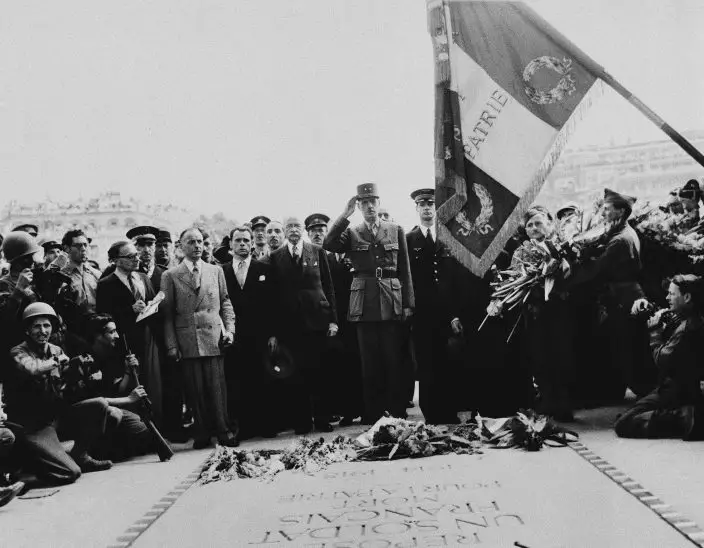
FILE - In this Aug. 28, 1944 file photo, General Charles De Gaulle, center, salutes the Tricolor after placing his wreath on the Tomb of the French Unknown Soldier of the last war, at the Arc de Triomphe in Paris. The fighting for the liberation of Paris took place from August 19 to August 25, 1944. The French Resistance staged an uprising against the Nazis, leading attacks against German soldiers and vehicles and building barricades in the streets of the French capital. (AP PhotoAndrew Lopez, File)
Two miles farther the column halted. Forward elements had run into a German strongpoint and mines on the road.
French Brig. Gen. Jacques Leclerc and his staff went into conference. Tanks wheeled and started to outflank the position, but after a while they returned because they ran into the route of an American infantry advance.
Then the column began to roll again. The strongpoint had been knocked out ahead of us. And at 9:57 a.m. my jeep rolled through the gates into Paris.
Never do I expect to see such scenes as I saw on the streets of Paris. There was only a narrow lane through which the armor could roll. Men and women cried with joy. They grabbed the arms and hands of soldiers and cheered until their voices were hoarse.
When the column stopped I was smothered, but pleasantly, with soft arms and lips giving not one kiss but the usual French double one. They hugged me and my jeep driver and pinned French tricolors on us, and left us exhausted, with our bosoms covered with emblems and ribbons.
One old man came up, saluted, and said with tears in his eyes: "God bless America. You have saved France."
Men and women, old and young, and children stormed the jeep every time the column stopped. And they were wild with emotion.
Crowds were banked from the center of the streets to the sidewalks in a colorful, cheering throng which stretched for miles. There seemed to be no end and apparently everyone in Paris except the Germans and collaborationists was standing there to cheer, shout, cry and leave themselves exhausted with happiness.
Our column moved to a point one block from the Luxembourg Gardens. Then from all sides burst machine-gun fire. From housetops and windows guns rattled. Machine guns of tanks opened up in reply. We leaped from the jeep and took cover behind a tank.
Jerry Beatson of Rockford, Ill., was beside me and leveled his carbine at the top of the building. The gun cracked in my ear.
"There's one ---- up there," he cried, and kept firing at the rooftop.
Bullets rattled on the streets and glanced off with ugly whines.
The crowds, which a few minutes before lined the streets, melted as if a blast from a furnace had hit a snowbank. Then the streets were terribly lonely and barren except for armor with guns clattering.
My driver and I leaped into a jeep and raced back down the street, but another burst of machine-gun fire sent us diving for the curb. We felt bare and exposed there in the street.
FFI resistance leaders crouched and ran from door to door, pointing to the rooftops and windows.
Up there, shooting down on us were the milice (Vichy collaborators) who were helping the Germans defend the city. One Frenchman said there were many German snipers in civilian clothes.
Red Cross aid men dressed in white ran out of a doorway with a stretcher. A nurse in starched white followed them. They picked up a wounded man and laid him on a stretcher while waving a Red Cross flag.
An FFI member ran up to me and cried in English: "Give us arms and ammunition. We want guns and bullets. That's all we ask. ... We haven't enough ammunition and most of us have only pistols."
Ahead of us, patriots crouched along the buildings and answered the enemy fire. Lying there, I felt lonely and lost in the city which all of us had dreamed of entering as a joyous occasion.
The drive on Paris began at 7 a.m. yesterday under sullen, drizzling skies. The French and American columns had moved into position on Wednesday afternoon facing the enemy's position west of Paris.
The Germans did not have much in front of us — but enough to make the armor move cautiously, and occasionally artillery would pound gun positions along the way.
Our column avoided the main road to Versailles and turned into a secondary road leading to the Grand National Highway running south of the city to Orleans. Other columns of armor, assault guns, half-tracks and supply trains fanned out on other roads. The historic move on paris was under way.
The column moved in lurches, going forward for short distances, then stopping, either for reconnaissance or for guns to engage strongpoints. Rain glistened on the dark green trees and hedges and gave the countryside a freshly washed appearance.
Ins small towns people crowded along the streets despite the rain, to wave tricolors and to cheer each vehicle that passed. Never have I seen more joyous faces than those along the road to Paris. It was a triumphal, exciting and colorful march.
Pretty girls stood on the roadside and tossed flowers at the vehicles. As the column would stop, they would deck the tanks and armored trucks with flowers until they seemed to be camouflaged as mobile flower pots. Farmers tossed fresh tomatoes and apples to the troops.
Sergt. Bob Fraley of Des Moines, Iowa; Private Ray Rooney of Glen Ellyn, Ill. And Pvt Harry Grant of Hamburg, Ark., sat in a jeep watching this outburst of emotion at the edge of the war.
"This is the first real holiday I've had in weeks," Farley said. "We've been doing reconnaissance up where the fighting really was tough. But this is like a circus."
Suddenly there was an uproar in the streets. Down the road came the French in lightweight summer uniforms which I last saw in the desert and Sicily. Most of them were middle-aged or older, but they looked well-fed and in excellent physical condition.
A ripple of excitement ran through the crowds.
The Maquis marched down the street with four women whose heads were bald as babies. The crowd jeered and heaped scorn on these women because they had kept company with German soldiers. One of the women glared defiantly at the crowds.
"That woman," someone said, "had a husband in Germany as a prisoner. He escaped and returned to her but she betrayed him to the Germans and was shot."
The other women hung their heads and stumbled along with their faces ashen and ugly from fear and embarrassment.
Late in the day the Germans shelled the town and sent the crowds scurrying to cover. Two shells burst squarely in the main street but the casualties fortunately were light among the civilians.
All night the guns dueled, but this was the enemy's last stand before Paris.
For more AP coverage of World War II: https://www.apnews.com/WorldWarII
PARIS (AP) —
Reuters photographer Mohammed Salem captured this year’s prestigious World Press Photo of the Year award Thursday with a depiction of loss and sorrow in Gaza, a heartrending photo of a Palestinian woman cradling the body of her young niece. The photograph, taken in Khan Younis just days after Salem’s own child was born, shows 36-year-old Inas Abu Maamar holding five-year-old Saly, who was killed along with her mother and sister when an Israeli missile struck their home.
Salem, who is Palestinian, described this photo filed Nov. 2 last year, as a “powerful and sad moment that sums up the broader sense of what was happening in the Gaza Strip.”
The image ”truly encapsulates this sense of impact,” said global jury chair Fiona Shields, The Guardian newspaper's head of photography. “It is incredibly moving to view and at the same time an argument for peace, which is extremely powerful when peace can sometimes feel like an unlikely fantasy,” she added.
The World Press Photo jury praised the shot’s sense of care and respect and its offering of a “metaphorical and literal glimpse into unimaginable loss.”
This is not the first time Salem has been recognized for his work on the Israeli-Palestinian conflict; he received a World Press Photo award more than a decade ago for another depiction of the human toll of conflict in the Gaza strip.
In the three other global categories announced Thursday, South Africa’s Lee-Ann Olwage won Photo Story of the Year for her touching series “Valim-babena,” featured in GEO magazine. The project focused on the stigmatization of dementia in Madagascar, a topic she explored through intimate portraits of “Dada Paul” and his family. Lack of public awareness surrounding dementia means that people displaying symptoms of memory loss are often stigmatized.
In the series, “Dada Paul,” who has lived with dementia for 11 years, is tenderly cared for by his daughter Fara. One of the standout images in the series shows him preparing for church with his granddaughter Odliatemix, capturing moments of normalcy and warmth amidst the challenges of dementia.
Photographer Alejandro Cegarra, a Venezuelan native who migrated to Mexico in 2017, won the Long-Term Project award for “The Two Walls,” published by The New York Times and Bloomberg. Cegarra’s project, initiated in 2018, examines a shift in Mexico’s immigration policies, which have moved from being historically open to enforcing strict regulations at its southern border. The jury said the photographer's perspective as a migrant gave it a “sensitive," human-centered perspective, according to a press release.
Julia Kochetova of Ukraine won the Open Format award for “War Is Personal.” The project stood out from coverage of the ongoing conflict by offering a personal look at the harsh realities of war. On a dedicated website, she merged traditional photojournalism with a diary-like documentary style, incorporating photography, poetry, audio clips and music.
The Associated Press won the Open Format award in the regional Africa category with the multimedia story “Adrift,” created by journalists Renata Brito and Felipe Dana. The story investigates the fate of West African migrants who attempted to reach Europe via a treacherous Atlantic route but ended up on a ghost ship discovered off Tobago. The team’s compelling use of photography, cinematography and detailed narrative, enhanced by expert design and multimedia elements, highlights the perils faced by migrants and the human stories behind global migration issues.
The Associated Press' Ebrahim Noroozi won the Asia Stories award for his series “Afghanistan on the Edge,” which documents the country since the Taliban took over in August 2021.
World Press Photo is an independent, nonprofit organization based in the Netherlands, founded in 1955.

This image provided by World Press Photo is part of a series titled Afghanistan on the Edge by Ebrahim Noroozi, Associated Press, which won the World Press Photo Asia Series category and showsAn Afghan refugee rests in the desert next to a camp near the Torkham Pakistan-Afghanistan border, in Torkham, Afghanistan, Friday, Nov. 17, 2023. A huge number of Afghans refugees entered the Torkham border to return home hours before the expiration of a Pakistani government deadline for those who are in the country illegally to leave or face deportation. (AP Photo/Ebrahim Noroozi)
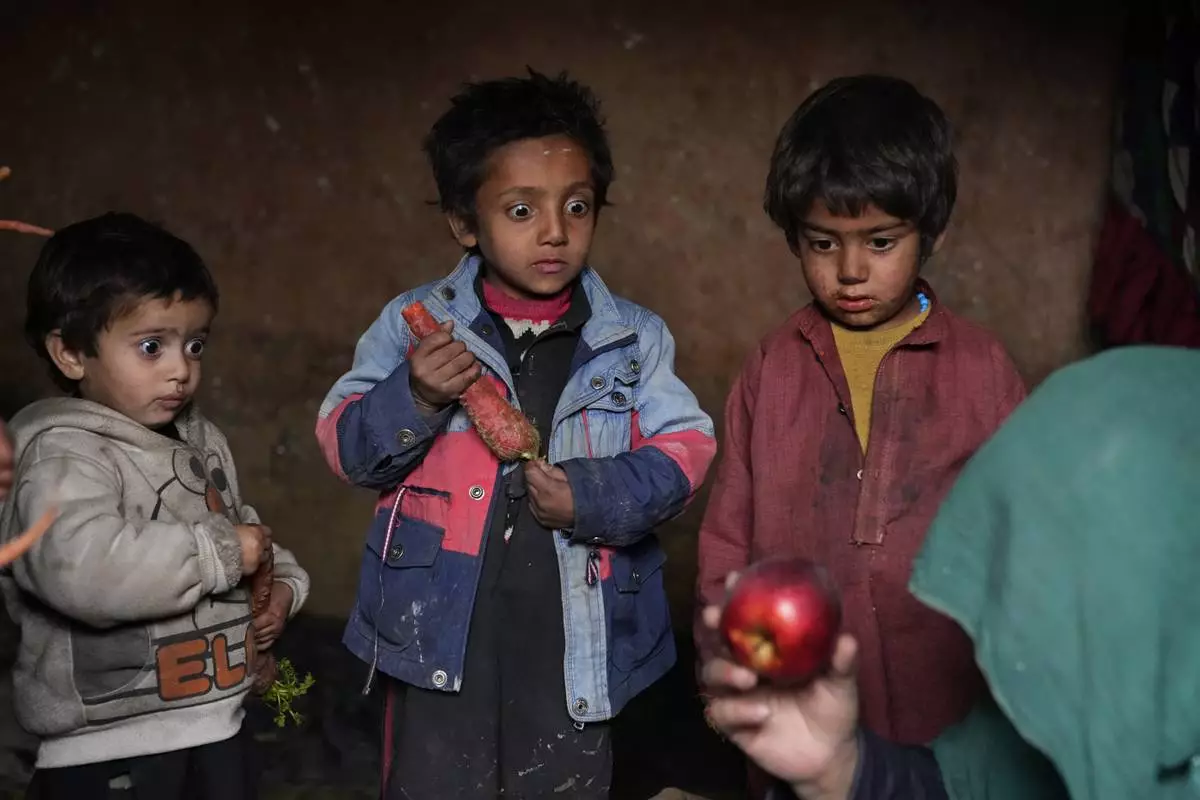
This image provided by World Press Photo is part of a series titled Afghanistan on the Edge by Ebrahim Noroozi, Associated Press, which won the World Press Photo Asia Series category and shows : Since the chaotic Taliban takeover of Kabul on Aug. 15, 2021, an already war-devastated economy once kept alive by international donations alone is now on the verge of collapse. There isn't enough money for hospitals. The World Health Organization is warning of millions of children suffering malnutrition, and the U.N. says 97% of Afghans will soon be living below the poverty line. Three Afghan internally displaced children look with surprise at an apple that their mother brought home after begging, in a camp on the outskirts of Kabul, Afghanistan, Thursday, Feb 2, 2023. (AP Photo/Ebrahim Noroozi)

This image provided by World Press Photo is part of a multimedia project by Associated Press' Renata Brito and Felipe Dana titled Adrift, won the World Press Photo Africa Regional Winner Open Format category and shows a mortuary technician opening the door of a refrigerator used to store the remains of migrants recovered from inside the Mauritania boat that appeared drifting near the island of Tobago, in Scarborough, Trinidad and Tobago, Tuesday, Jan. 25, 2022. In May 2021 a boat from Mauritania full of dead men was found off the coast of the Caribbean Island of Tobago. Who were these men and why were they on the other side of the Atlantic Ocean? Two visual journalists sought answers, uncovering a story about migrants from West Africa who seek opportunity in Europe via an increasingly popular but treacherous Atlantic route. (AP Photo/Felipe Dana)
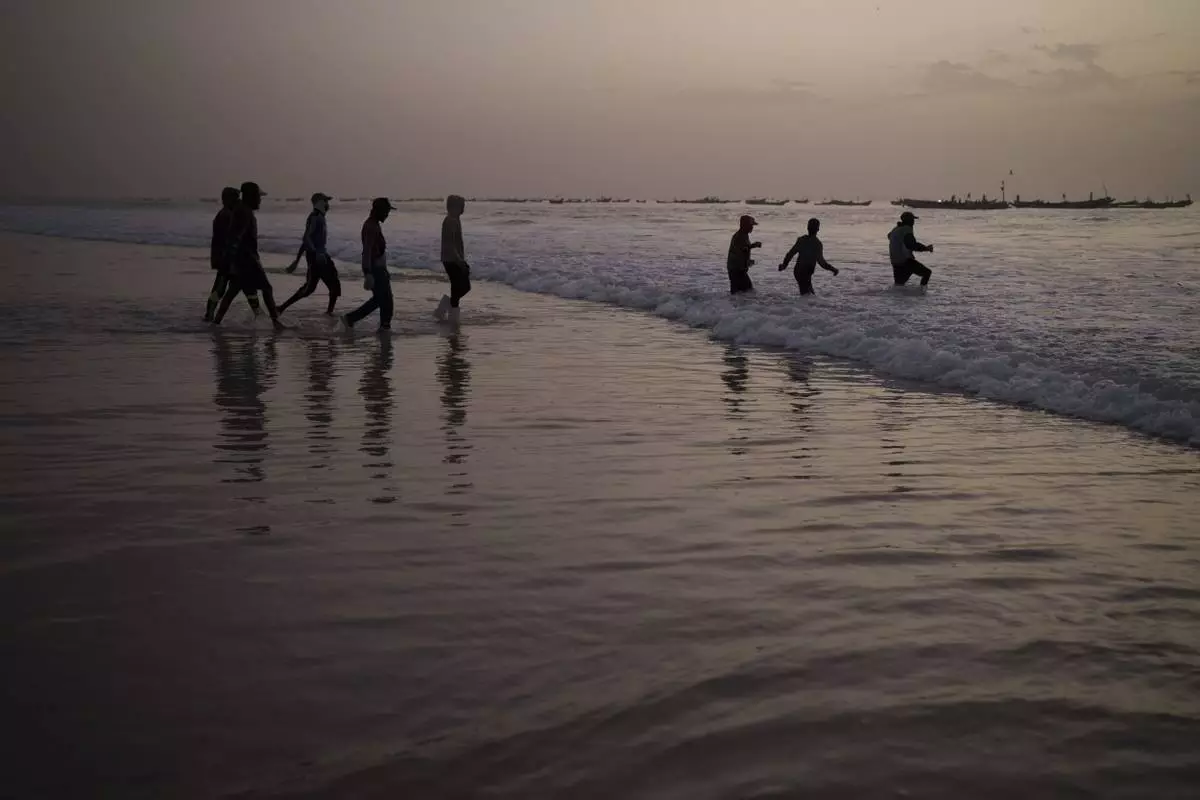
This image provided by World Press Photo is part of a multimedia project by Associated Press' Renata Brito and Felipe Dana titled Adrift, won the World Press Photo Africa Regional Winner Open Format category and shows young fishermen walk into the ocean to board an artisanal fishing boat in Nouakchott, Mauritania, Friday, Dec. 10, 2021. In May 2021 a boat from Mauritania full of dead men was found off the coast of the Caribbean Island of Tobago. Who were these men and why were they on the other side of the Atlantic Ocean? Two visual journalists sought answers, uncovering a story about migrants from West Africa who seek opportunity in Europe via an increasingly popular but treacherous Atlantic route. (AP Photo/Felipe Dana)
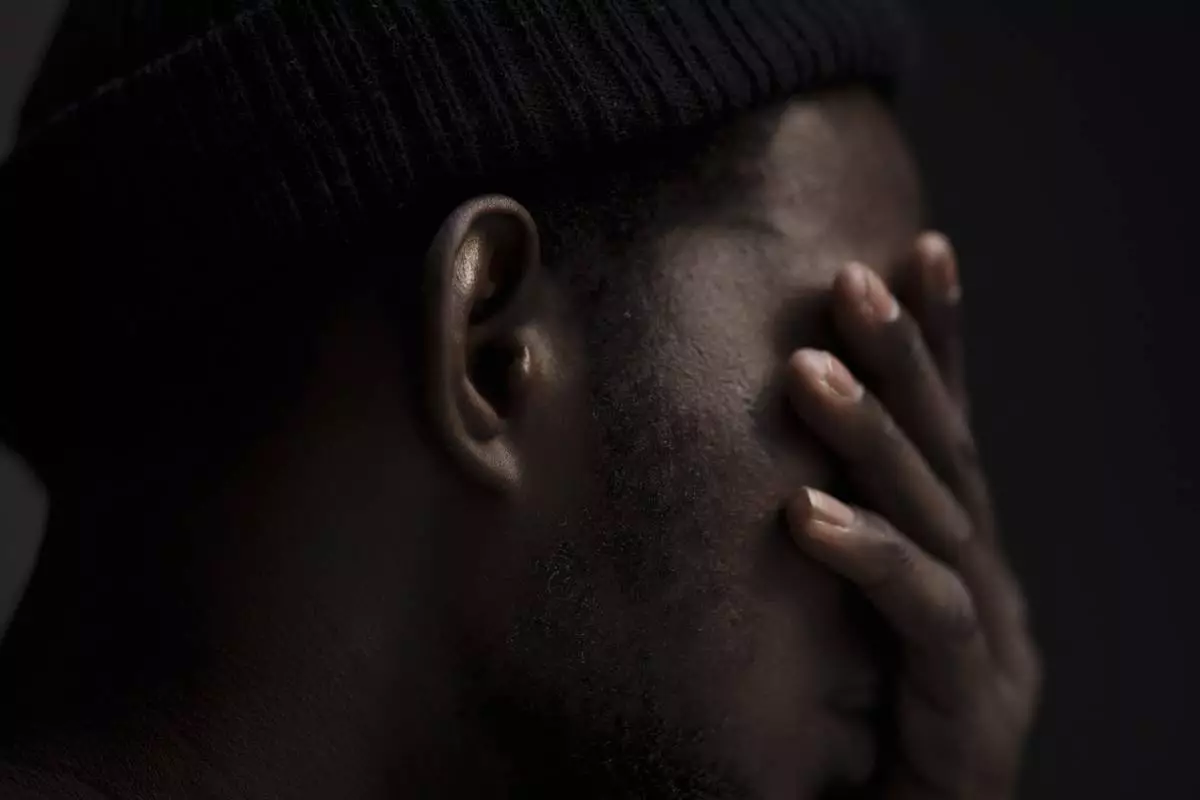
This image provided by World Press Photo is part of a multimedia project by Associated Press' Renata Brito and Felipe Dana titled Adrift, won the World Press Photo Africa Regional Winner Open Format category and shows Moussa Sako, an asylum-seeker from Mali, who survived 22 days aboard a Mauritanian boat drifting in the Atlantic Ocean covers his face during an interview with the Associated Press in Guadalajara, Spain, Sunday, Nov. 14, 2021. In May 2021 a boat from Mauritania full of dead men was found off the coast of the Caribbean Island of Tobago. Who were these men and why were they on the other side of the Atlantic Ocean? Two visual journalists sought answers, uncovering a story about migrants from West Africa who seek opportunity in Europe via an increasingly popular but treacherous Atlantic route. (AP Photo/Felipe Dana)
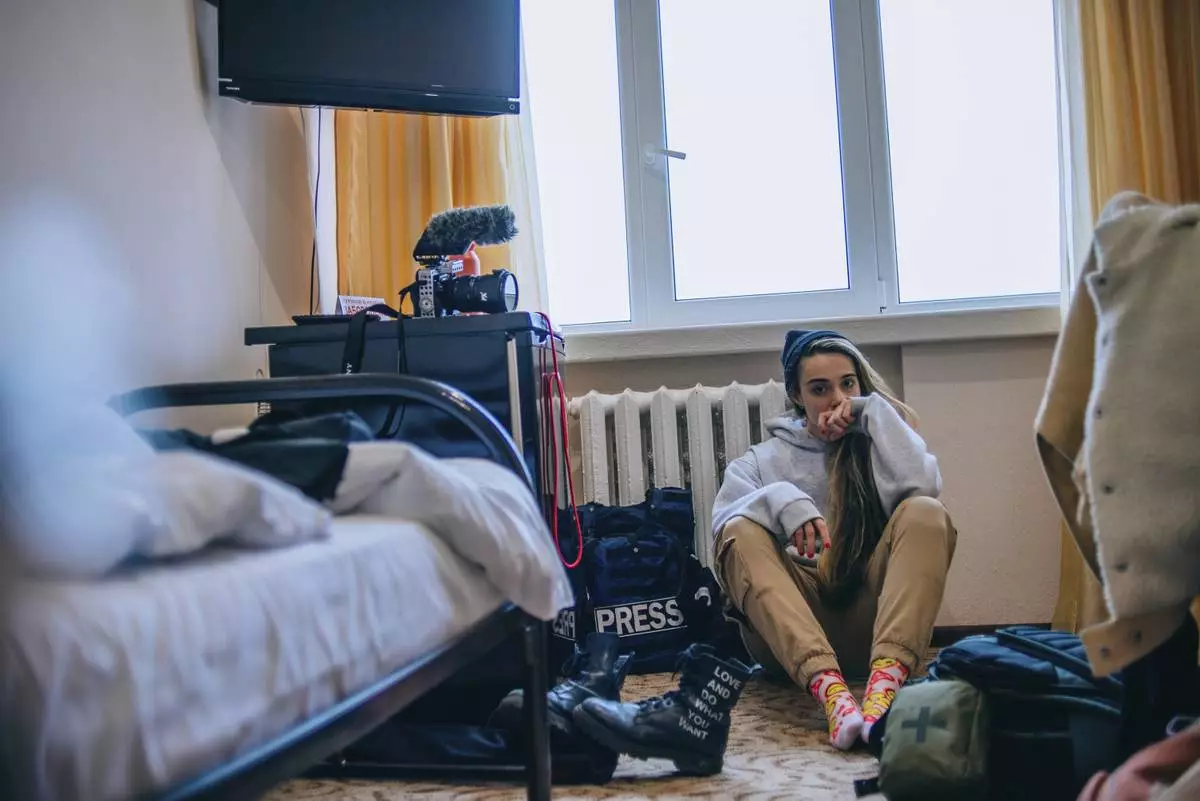
This image provided by World Press Photo and taken by Julia Kochetova is part of a series titled War is Personal which won the World Press Photo Open Format Award. Amidst tens of thousands of civilian and military casualties and an effective stalemate that has lasted for months, there are no signs of peace on the horizon for Russia's war in Ukraine. While news media updates its audience with statistics and maps, and international attention drifts elsewhere, the photographer has created a personal website that brings together photojournalism with the personal documentary style of a diary to show the world what it is like to live with war as an everyday reality. (Julia Kochetova/World Press Photo via AP)
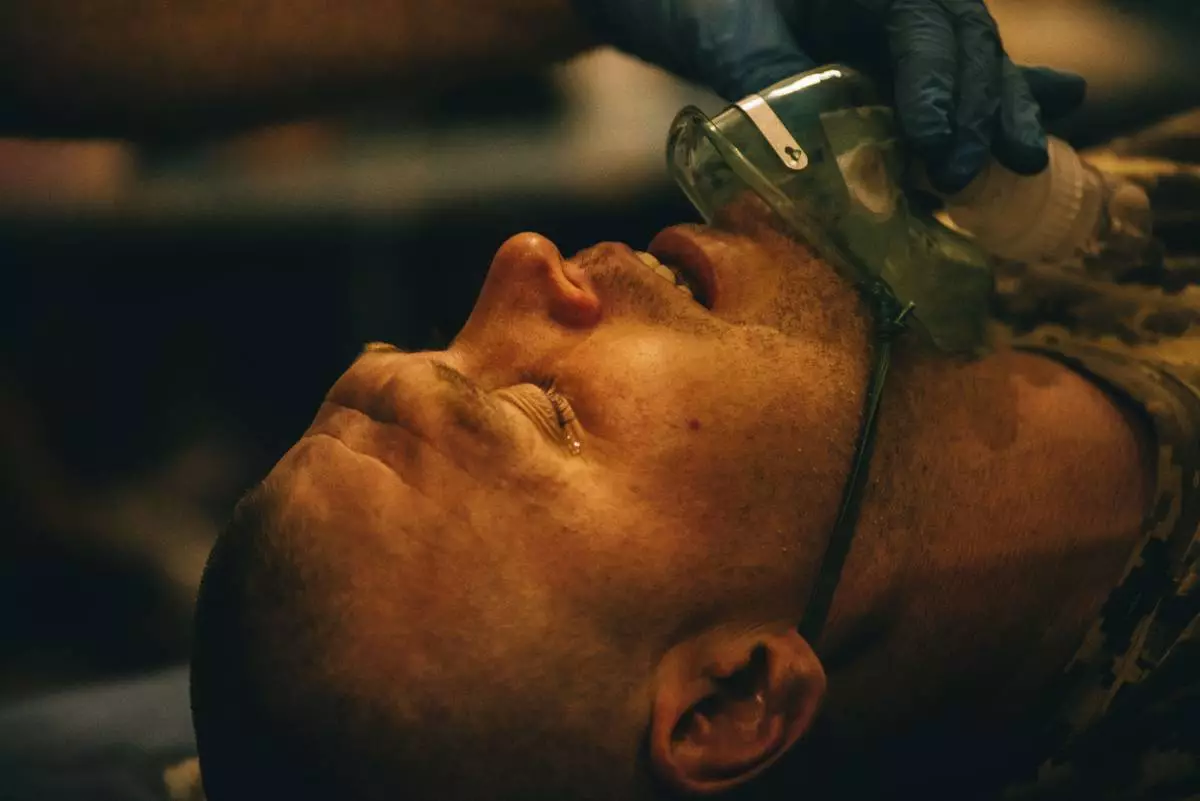
This image provided by World Press Photo and taken by Julia Kochetova is part of a series titled War is Personal which won the World Press Photo Open Format Award and shows a stabilization point near Bakhmut, Ukraine, of the 5th assault brigade and 77th brigade. Hospitalliers battalion - volunteer battalion of combat medics are helping here. Amidst tens of thousands of civilian and military casualties and an effective stalemate that has lasted for months, there are no signs of peace on the horizon for Russia's war in Ukraine. While news media updates its audience with statistics and maps, and international attention drifts elsewhere, the photographer has created a personal website that brings together photojournalism with the personal documentary style of a diary to show the world what it is like to live with war as an everyday reality. (Julia Kochetova/Der Spiegel/World Press Photo via AP)
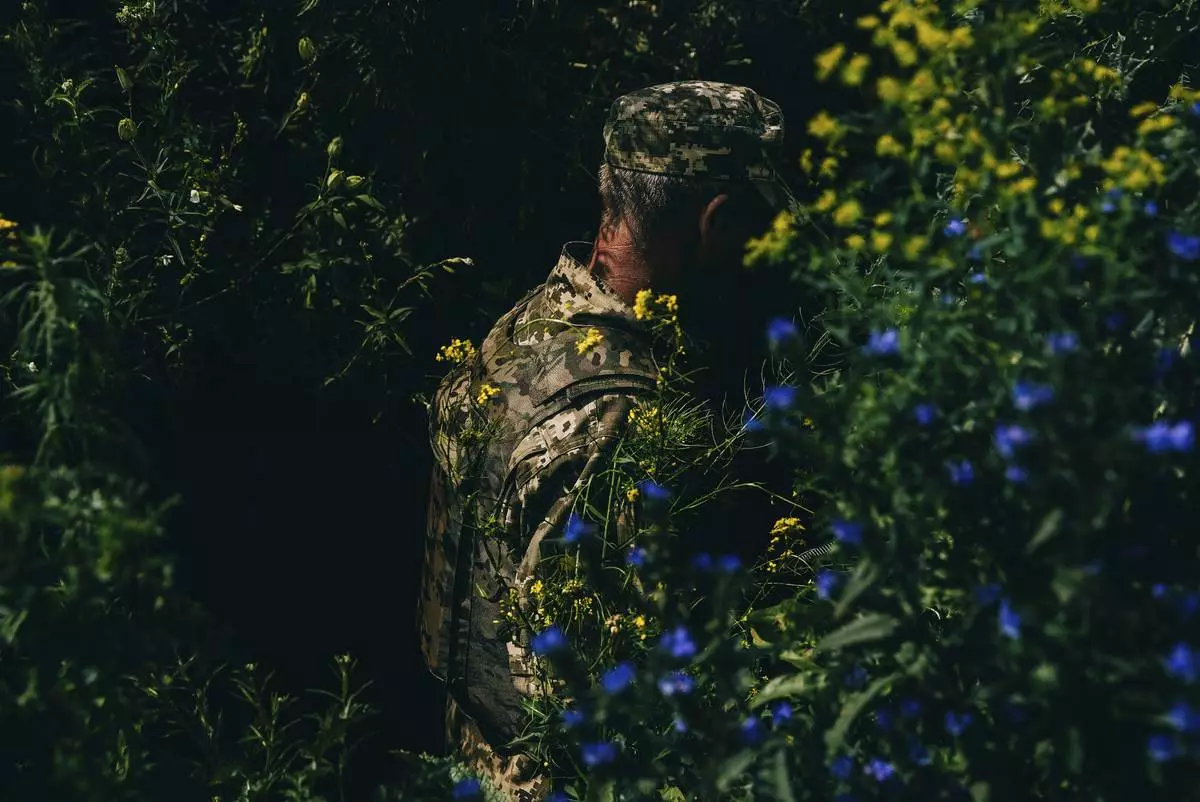
This image provided by World Press Photo and taken by Julia Kochetova is part of a series titled War is Personal which won the World Press Photo Open Format Award and shows the training of mobilized conscripts of 68th brigade in Donetsk region, not far from frontline. 68th brigade recently liberated Blagodatne village during the Ukrainian counter-offensive. The instructors came from US, working for NGO "Saber".Amidst tens of thousands of civilian and military casualties and an effective stalemate that has lasted for months, there are no signs of peace on the horizon for Russia's war in Ukraine. While news media updates its audience with statistics and maps, and international attention drifts elsewhere, the photographer has created a personal website that brings together photojournalism with the personal documentary style of a diary to show the world what it is like to live with war as an everyday reality. (Julia Kochetova/Der Spiegel/World Press Photo via AP)
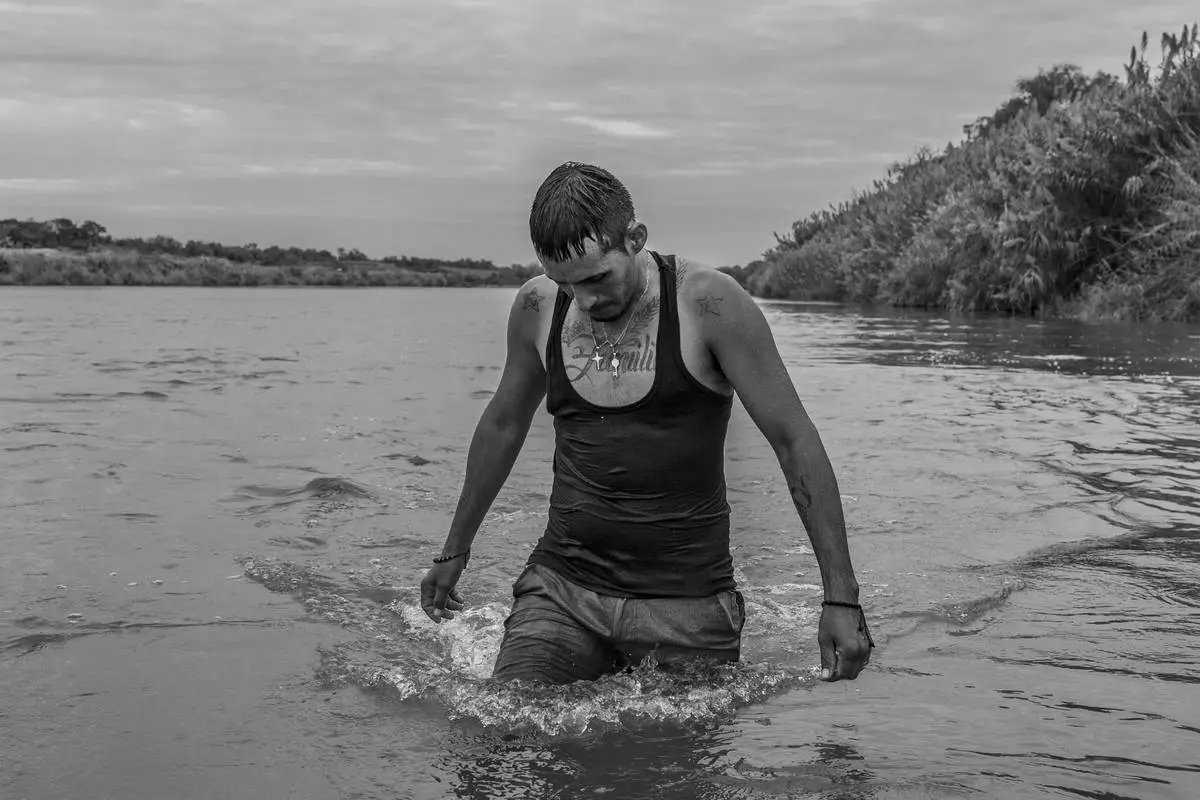
This image provided by World Press Photo and taken by Alejandro Cegarra for The New Times/Bloomberg is part of a series titled The Two Walls which won the World Press Photo Long-Term Project Award and shows Carlos Mendoza, a Venezuelan migrant, crossing the Rio Grande river to seek asylum in the United States. Piedras Negras, Mexico, 7 October 2023. (Alejandro Cegarra/The New York Times/Bloomberg/World Press Photo via AP)
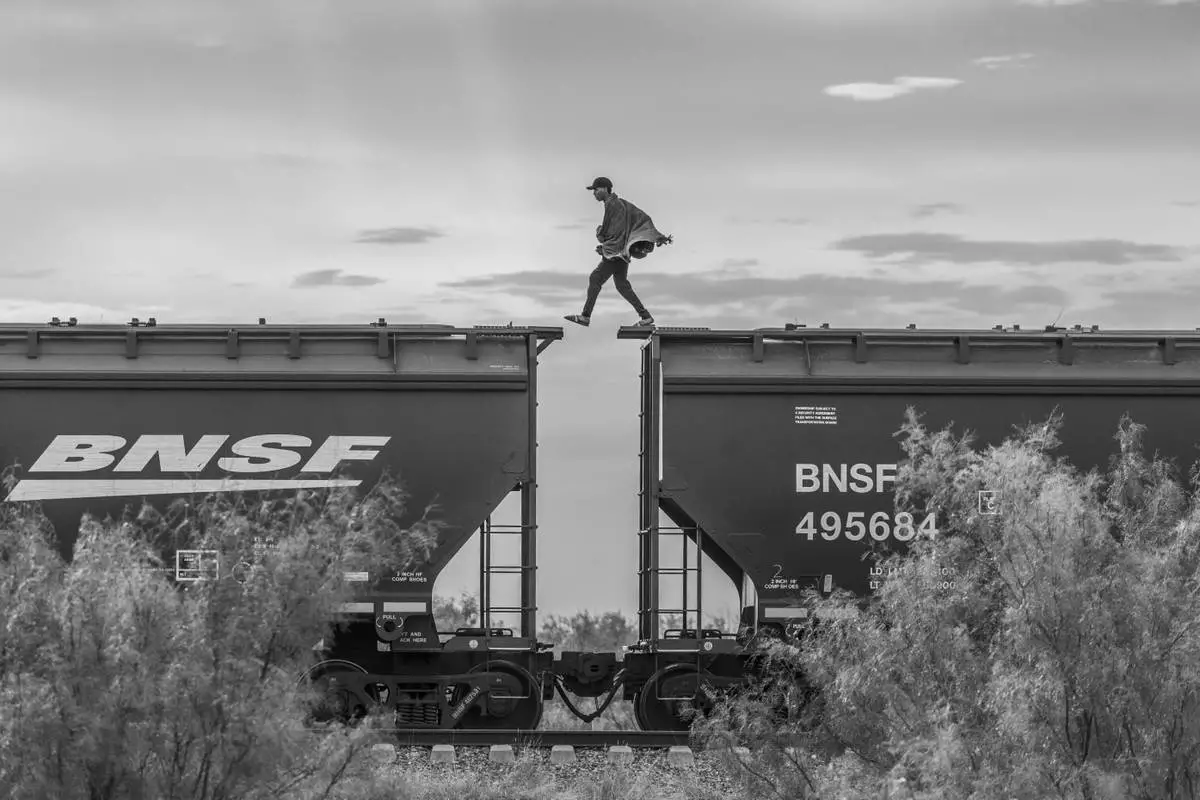
This image provided by World Press Photo and taken by Alejandro Cegarra for The New Times/Bloomberg is part of a series titled The Two Walls which won the World Press Photo Long-Term Project Award and shows a migrant walking atop a freight train known as "The Beast." Migrants and asylum seekers lacking the financial resources to pay a smuggler often resort to using cargo trains to reach the United States border. This mode of transportation is very dangerous; over the years, hundreds have fallen onto the tracks and have been killed or maimed. Piedras Negras, Mexico, 8 October 2023. (Alejandro Cegarra/The New York Times/Bloomberg/World Press Photo via AP)
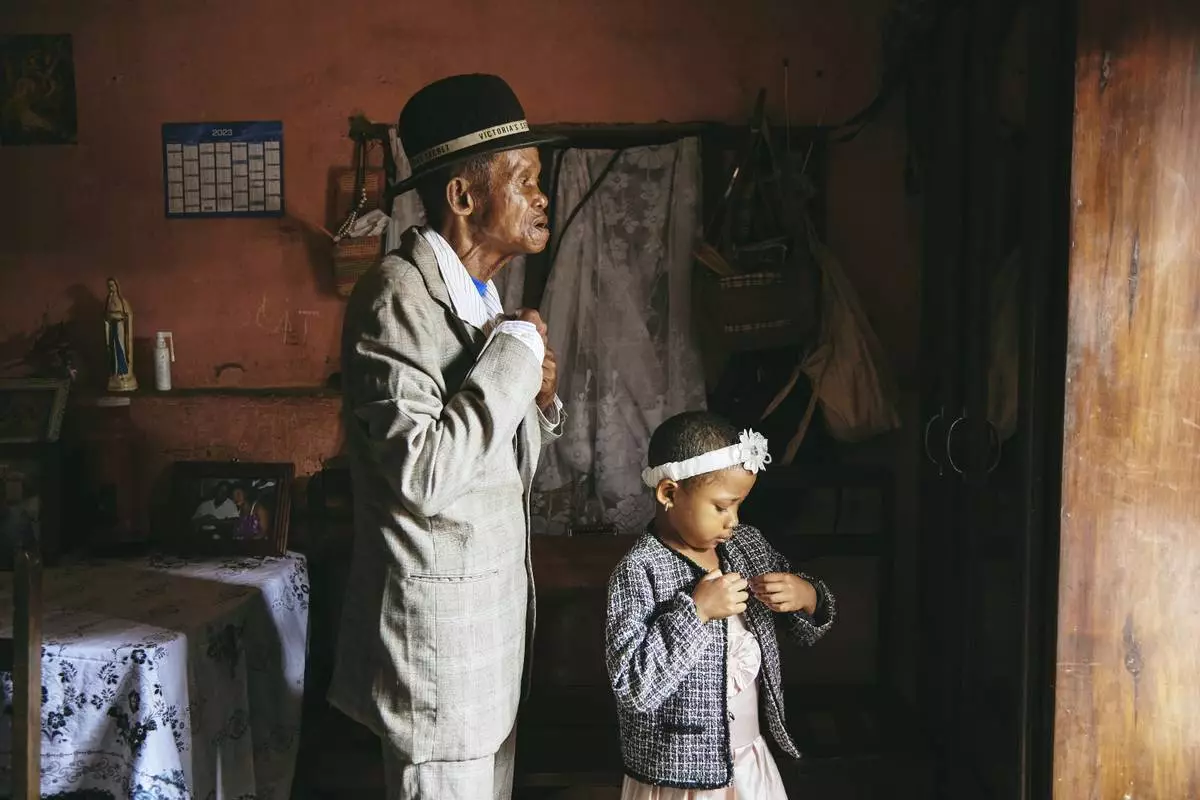
This image provided by World Press Photo and taken by Lee-Ann Olwage for GEO is part of a series titled Valim-babena which won the World Press Photo Story of the Year Award and shows Dada Paul Rakotazandriny (91), who is living with dementia, and his granddaughter, Odliatemix Rafaraniriana (5), get ready for church on Sunday morning at his home in Antananarivo, Madagascar. 12 March 2023. (Lee-Ann Olwage/Geo/World Press Photo via AP)
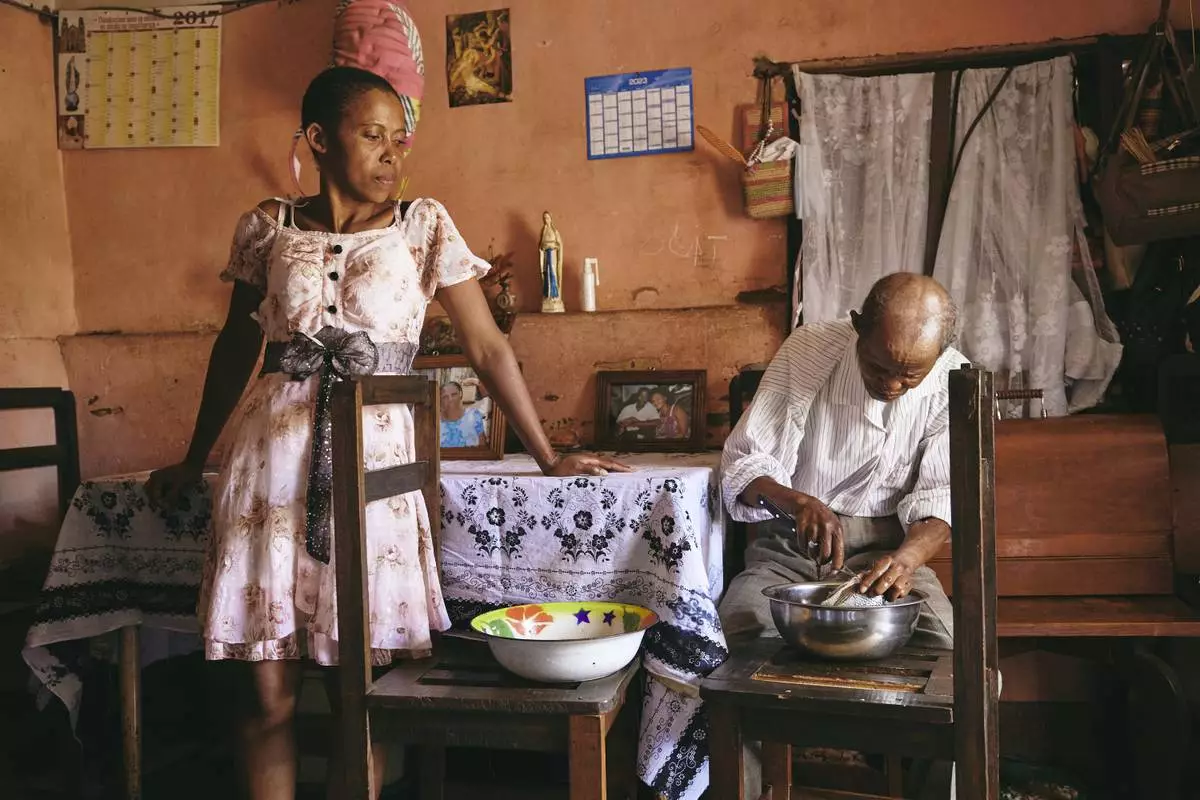
This image provided by World Press Photo and taken by Lee-Ann Olwage for GEO is part of a series titled Valim-babena which won the World Press Photo Story of the Year Award and shows Joeline (Fara) Rafaraniriana (41) watches her father, Dada Paul Rakotazandriny (91) clean fish at home on Sunday afternoon. A typical Sunday consists of the family attending church in the morning and spending time together in the afternoon. Fara works during the week and as the sole provider and carer for her daughter and father struggles to manage all her responsibilities in the absence of assistance by her siblings who live close by. Mandrosoa Ivato, Antananarivo, Madagascar. 12 March 2023. (Lee-Ann Olwage/Geo/World Press Photo via AP)
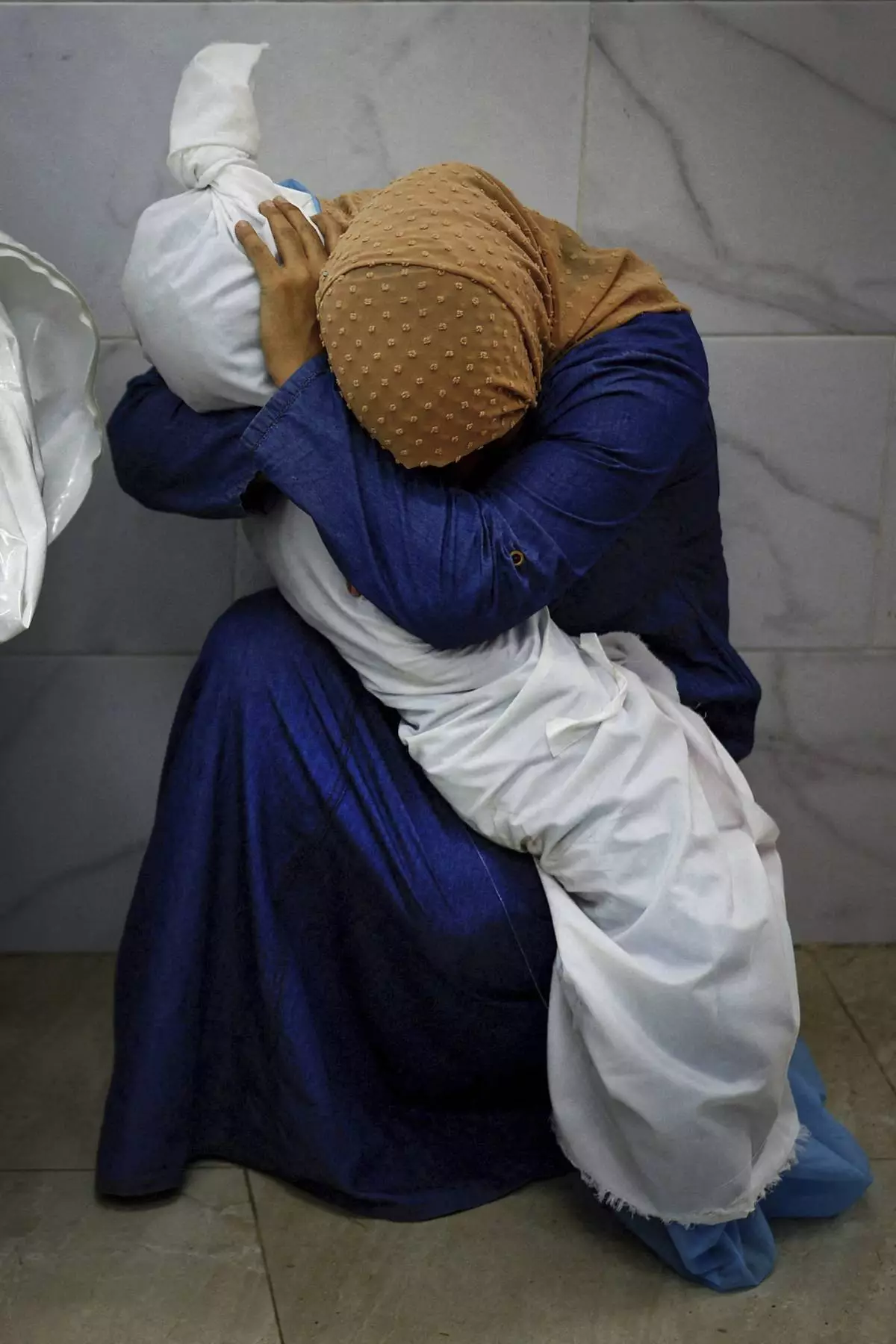
This image provided by World Press Photo and taken by Mohammed Salem of the Reuters news agency won the World Press Photo Award of the Year and shows Palestinian woman Inas Abu Maamar, 36, embracing the body of her 5-year-old niece Saly, who was killed in an Israeli strike, at Nasser hospital in Khan Younis in the southern Gaza Strip, October 17, 2023. (Mohammed Salem/Reuters/World Press Photo via AP)























